|
Week 4: August 22-28, 2008 |
Welcome
to the McGill Bird Observatory weekly report.
Click here for a complete listing of our archives.
Comments or
questions are welcome at "mbo AT migrationresearch.org".
|
PICTURE
OF THE WEEK: |
|
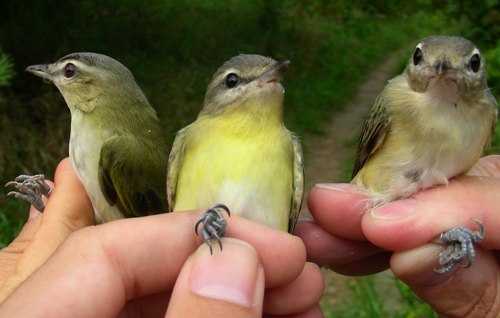
A rare treat on Thursday was this trio of vireos (left to right: Red-eyed, Philadelphia, and
Warbling) all caught on the same net round, the latter two just a metre apart in net D4.
Last fall we banded just one Philadelphia Vireo, so we had to take advantage of the
opportunity to compare the species. Note in particular the yellow throat and upper
breast of the Philadelphia Vireo in comparison with the Warbling, and also its darker
lores in contrast with the more pale face of the Warbling.
(Photo by Marcel Gahbauer)
|
|
|
THIS WEEK |
THIS FALL |
2008 TOTAL |
SITE TOTAL |
|
# birds (and species) banded |
166 (35) |
694 (52) |
1536 (75) |
14514 (105) |
|
# birds (and species) repeat |
36 (12) |
176 (27) |
374 (39) |
2600 (63) |
|
# birds (and species) return |
1 (1) |
12 (7) |
104 (21) |
435 (31) |
|
# species observed |
76 |
105 |
146 |
195 |
|
# net hours |
560 |
1905.8 |
4818.0 |
26763.8 |
|
# birds banded / 100 net hours |
29.5 |
36.4 |
31.9 |
54.2 |
|
|
Note: table does not include nocturnal banding (owls) |
|
Banders-in-charge: Barbara Frei, Marcel Gahbauer, Marie-Anne Hudson
Assistants: Simon Duval, Nicki Fleming, Gay Gruner, Marie-Mellissa Kalamaras, Helen Leroux, Barbara MacDuff, Barry Mantal, Chris Murphy, Rodger Titman
Notes: As expected, week 4 was fairly quiet, with the normal end of August lull resulting from the breeding species starting to slip away and many of the migrants we know will come, just not quite here yet. Despite the lower numbers, we were treated to an interesting mix of species, with several warbler species kicking around, and banding was slow but steady most days. Compared to last year, as well as last week, we are still ahead with both number of individuals and species banded. All in all, a nice week for our volunteers (and banders!) to brush up on things, enjoy a nice unhurried look at some uncommon species and get inspired for the rush ahead!
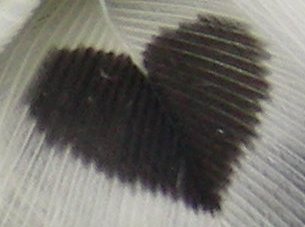
Time for a quiz: believe it or not, this closeup photo is enough to identify not only the species, but also give a clue to its sex! See the bottom of this week's update for the answer.
(Photo by Marcel Gahbauer)
|
Even a slow week can have significant highlights. This week, the biggest news was the addition of a 195th species to our all-time MBO checklist, a Common Nighthawk spotted first thing Wednesday morning. We also saw a Peregrine Falcon for the first time this year, and added Spotted Sandpiper, Orange-crowned Warbler, and Blackpoll Warbler to our list for this fall. In terms of banding, we got our first Eastern Phoebe and Blackburnian Warbler of the year, and our first Philadelphia Vireo and Blackpoll Warbler of the fall.
This week’s
top 10
[last week’s rank in brackets]
#
individuals banded |
mean # individuals observed daily |
1. Magnolia Warbler (19) [2] |
1.
Common Grackle (28) [2] |
2.
American Redstart (17) [1] |
2.
American Crow (26) [1] |
3.
Common Yellowthroat (14) [5] |
3.
Blue Jay (15) [7] |
4.
Nashville Warbler (11) [10] |
3. Black-capped Chickadee (15) [3] |
5.
Song Sparrow (8) [3] |
5. American Robin (11) [5] |
6.
Mourning Warbler (6) [-] |
6.
American Goldfinch (10) [4] |
6.
Tennessee Warbler (6) [-] |
7. Song Sparrow (8) [8] |
6. Wilson's Warbler (6) [-] |
8.
Cedar Waxwing (7) [6] |
9. Baltimore Oriole (5) [5] |
9. Common Yellowthroat (6) [9] |
9. Black-throated Blue Warbler (5) [-] |
10.
Gray Catbird (5) [-] |
|
Common Grackles claim the top spot for birds observed on site this week, with groups from several individuals to 50 or more seen, but they all stayed high and tended to move past MBO rather than lingering. The noisy and familiar Blue Jays, Black-capped Chickadees, and American Robins were also common sightings this week. Although small groups are seen daily, there seem to be fewer Cedar Waxwings than last year, and the House Wren family and friends must have moved on, since their chatter is no longer heard around every corner. Though not nearly common enough yet to make it into the table, we have been starting to see some raptors pass by, especially during our closing hour, the highlight on Tuesday being some prolonged interactions among Sharp-shinned, Broad-winged, and Red-tailed Hawks in the sky above while we compiled our daily totals.
For the top ten banded, well, bring on the warblers. With 8 out of the top 10 species, the warblers though small in number are fair of face. As last year at this time, Magnolia Warblers and American Redstarts are at the top of the list. Strangely enough Black-throated Blue Warblers are at the bottom, same place as last year too! Missing this year compared to last are the Red-eyed Vireos, which are around but not nearly in the same number as last year. Instead the chattering Common Yellowthroats found their way into our nets in surprising numbers, giving them the number 3 spot. We were very lucky to get several Mourning Warblers as well, with 2/3 of last falls total number banded in this week alone.
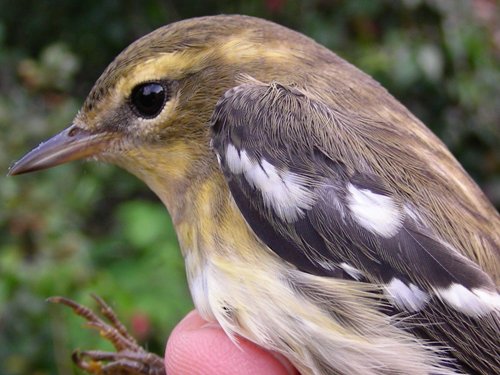
We didn't band a single Blackburnian Warbler in fall 2007, so were very pleased to have this hatch-year female visit us this week .
(Photo by Marcel Gahbauer)
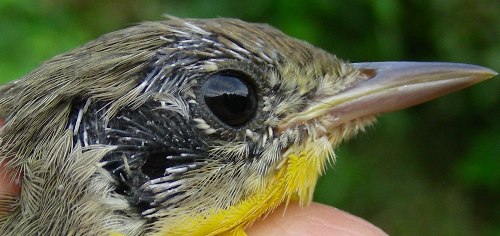
This scruffy-looking hatch-year Common Yellowthroat provided a good reminder that one needs to look closely at the face for black feathers - in this case while it looks black and might be called a male at a glance, the feathers aren't actually far enough out of their dark shafts to tell (note the exposed ear) .
(Photo by Marcel Gahbauer)
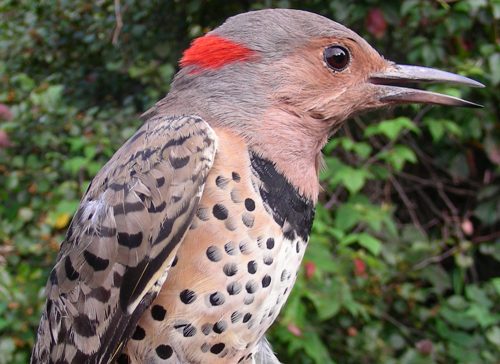
And here's the mystery bird, a Yellow-shafted Flicker! While the spots on the upper breast are more circular, those on the lower breast are heart-shaped on females - though beware it isn't a failsafe field mark, as some males do have heart-shaped spots too.
(Photo by Marcel Gahbauer)
|





